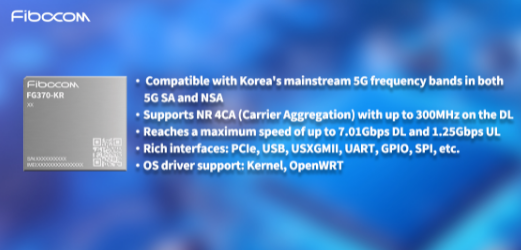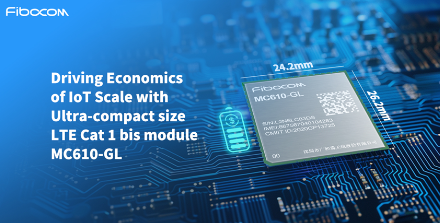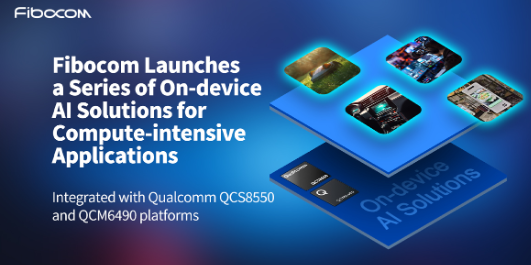Fibocom:How PoC Ensures Boundary-Free Wireless Communication for Industries?
What is PoC and What are the differences between PTT (Push-to-Talk)
PoC, shortened for Push-to-talk over cellular, is commonly seen among citizens and vertical industries users, and the way it operates for group users is as easy as the saying, push a button then voice speaks out loud. Developed through the 2G generation to 5G nowadays, the global Push-to-Talk over Cellular market size was valued at USD 4003.0 million in 2021 and is expected to expand at a CAGR of 11.99% during the forecast period, reaching USD 7898.26 million by 2027, according to the 360 Market Updates.
Several factors are driving the popularity of PoC, but firstly we are going to understand the differences between Push-to-Talk over Cellular (PoC) and Push-to-Talk (PTT) from the perspective of range, coverage, and data transmission.
· Traditionally, PTT was associated with two-way radio systems that operate on dedicated radio frequencies. It allows a group of people to make instant communication through a handheld device in a certain range, which has greatly improved communication efficiency and reduced the billing of long-distance calls. However, PoC is built-in with cellular technology like 4G, and 5G, and relies on telecom operators’ public networks to transmit the data, which allows cross-border data roaming in mobile scenarios, taking logistics vehicles for example, the vehicle loaded with cargo is departing from France to Belgium, and the driver can still communicate with his fellow workers through the PoC device in real-time.
· The infrastructure of the traditional PTT systems is based on the dedicated spectrum, such as private radio networks (Tetra, DMR, PDT), which is crucial for specific scenarios that require instant, interruption-free and emergency situation. While PoC relies on the coverage of cellular carriers’ networks.
· In the aspect of data transmission, PoC leverages the 4G/5G cellular technologies to extend digital capabilities for multimedia applications such as data, voice, and video transmission. But traditional PTT mainly supports voice and a few data applications.
How does 5G IoT extend the capability of PoC to meet the versatile market demands?
Stemming from the “Walkie Talkie”, the PoC has evolved with a bundle of functionalities beyond voice, similar to a rugged smartphone with multimedia features and operating systems, most importantly, it has irreplaceable value for the vertical industries.
Logistics and Fleet Management

Teams in logistics and fleet management are dispersed across various locations, cross-country commutes are necessary in daily operation. Deploying the PoC devices is an effective approach to streamline the communication protocol and ensure smooth coordination among employees as it is equipped with 4G/5G cellular capability and supports global roaming.
Real-time communication: business operators can smartly dispatch, and instruct essential updates to drivers on the road in real-time. This facilitates the coordination of route changes, traffic conditions, cargo delivery status, etc.
Documentation for future optimization, this can be useful for the documentation of the communication records, and offer better solutions for route planning.
Merging with GNSS function to trace the position in real-time.
Manufacturing and Warehousing
Manufacturing sites often require coordination with several departments, the instant communication enabled by the PoC device is crucial in synchronizing the messages across multiple departments, contributing to the decision-making process and reducing downtime.
Warehouse operations rely on intelligent inventory management systems and well-organized employees to realize efficient inventory management. Benefiting from 5G’s capacity, PoC devices pre-installed with the warehouse management operating system enable the real-time communication of inventory levels, restocking needs, and location updates, improving accuracy and reducing errors.
Construction and Mining
Site Coordination: Construction and mining sites often cover vast areas and reach deep undergrounds where the public network is out of range. Business owners can gain dedicated network resources through authorization from local authorities, thus enabling interference-free group communications between various teams spread across these sites via the PoC devices, allowing quick coordination between supervisors, equipment operators, engineers, and safety personnel.
Safety and Emergency Response: Safety is paramount in these industries. Benefiting from 5G’s millisecond latency and bandwidth, PoC facilitates instant communication in emergencies, allowing remote operators to view real-time status through video transmission, enabling swift response times and ensuring that safety protocols are promptly followed.
The infusion of 5G renovates the PoC industry with an extension of new capabilities
Leveraging the high bandwidth and capacity of 5G technology, the PoC will experience minimum delays, high qualify multimedia communications, and enhanced scalabilities.
The PoC can develop more customized industry applications thanks to the support of the Android system, allowing functionalities such as ID verification through fingerprints/ID card scanning. Limited by the bandwidth of 4G, LTE PoC can not well support real time or smooth HD video applications, while 5G empowers the PoC with rich multimedia functions such as uploading the HD video to the management center in real-time without comprising the resolution, which is a crucial feature for emergencies. In the latest 3GPP Release 17, NTN (Non-terrestrial Networks) was introduced to provide an uninterrupted connection to the IoT applications on land, high-altitude space, and ocean, especially important for keeping track of remote operations at a global scale.
Fibocom’s industry know-how for the highly integrated 4G/5G PoC device
As mentioned above, “PoC is similar to a rugged smartphone with multimedia features and operating systems”, and the complexity of integrating the cellular capability, multimedia functions, communication protocols, operating systems, and GNSS into one smart device at a compact size is obvious a big challenge for the device manufacturer.
Fibocom offers a highly integrated PCBA (Printed Circuit Board Assembly) solution customized for the PoC industry. Based on Fibocom’s 4G/5G smart module portfolio, which adopts high-performance CPU and GPU backed by the features from the chipset platform, the module allows the edge computing process to be conducted on the edge device. In addition to the support of a rich extension of interfaces such as MIPI/ USB/ UART/ SPI/ I2C, etc, along with Android OS, the smart module structures the foundation of the PoC device. Furthermore, the assembly know-how stems from Fibocom’s accumulation in the PoC industry evolving since the 2G era, by integrating the smart module, PCB assembly, and hardware ID & MD evaluation into the offering as the reference design for customer’ PoC devices, will significantly simplify the manufacturing process, optimize the cost-ratio, improve the efficiency and product quality, helping customers to reduce the time to market.
在线留言询价

Fibocom Fosters Local 5G AIoT Market with Newly Launched 5G Module FG370-KR at AIoT Korea 2024
- 一周热料
- 紧缺物料秒杀
| 型号 | 品牌 | 询价 |
|---|---|---|
| MC33074DR2G | onsemi | |
| BD71847AMWV-E2 | ROHM Semiconductor | |
| TL431ACLPR | Texas Instruments | |
| CDZVT2R20B | ROHM Semiconductor | |
| RB751G-40T2R | ROHM Semiconductor |
| 型号 | 品牌 | 抢购 |
|---|---|---|
| STM32F429IGT6 | STMicroelectronics | |
| BU33JA2MNVX-CTL | ROHM Semiconductor | |
| ESR03EZPJ151 | ROHM Semiconductor | |
| TPS63050YFFR | Texas Instruments | |
| BP3621 | ROHM Semiconductor | |
| IPZ40N04S5L4R8ATMA1 | Infineon Technologies |
- 周排行榜
- 月排行榜
AMEYA360公众号二维码
识别二维码,即可关注



























